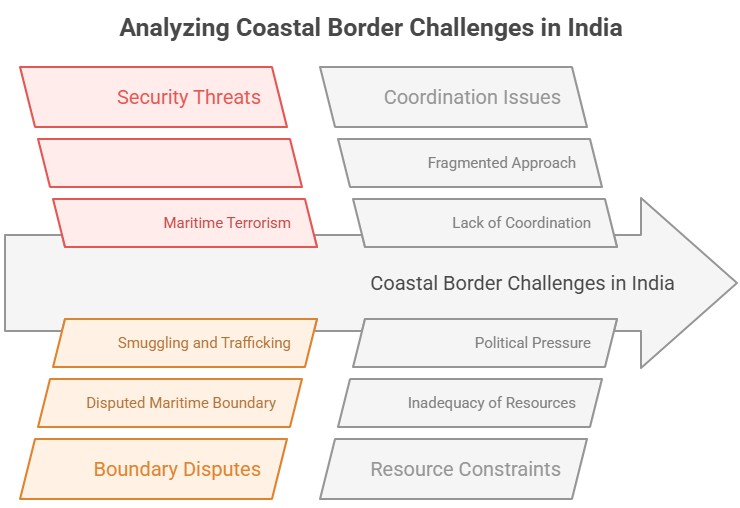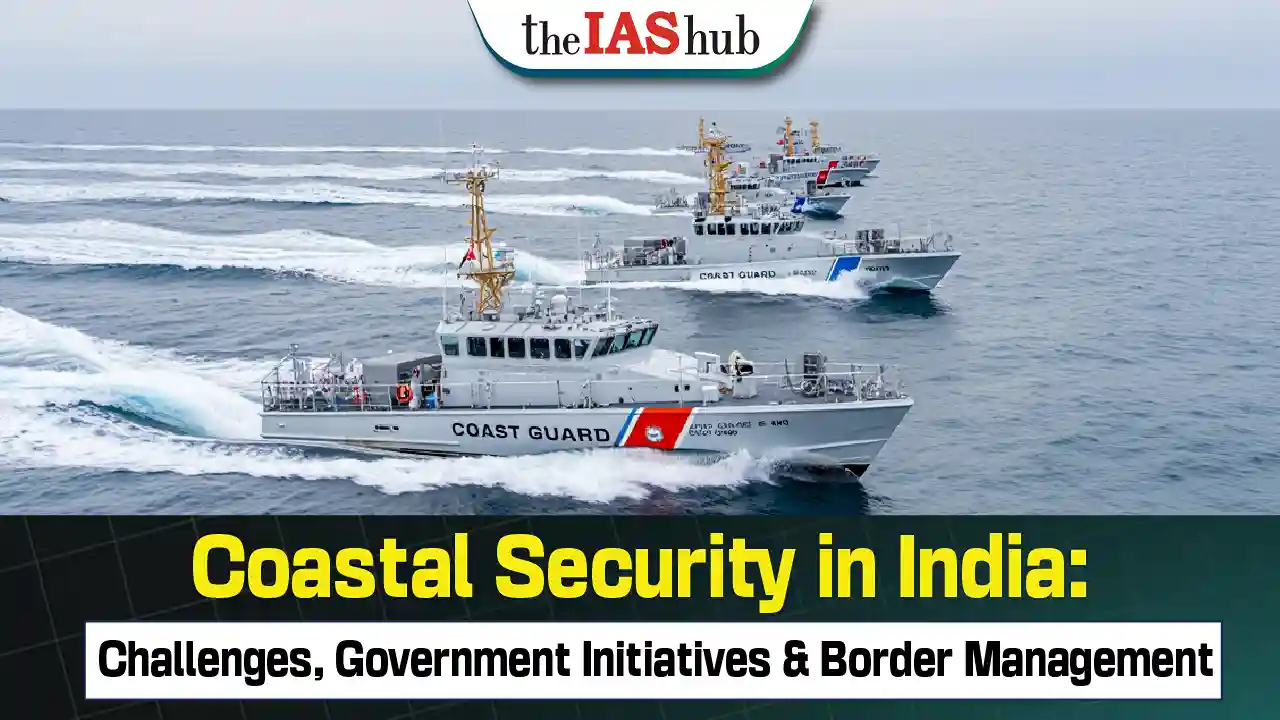India boasts a vast coastline spanning over 7,000 kilometres, accompanied by more than 1,000 offshore islands, offering abundant resources and immense opportunities. Preserving the sanctity of these waters against external threats and safeguarding India's maritime interests holds paramount significance, particularly in the prevailing geopolitical and security landscape.


Necessity of Coastal Security in India
- Diversity of topography – creeks, small bays, back waters, lagoons, swamps, small islands etc and absence of physical barriers on the coast.
- Unsettled maritime boundaries – With Pakistan (Sir Creek) poses not only serious security challenges but also hinder offshore development.
- Vulnerable to Maritime terrorism & anti-national activities - 1993 Mumbai blasts, 2008 Mumbai terrorist attacks.
- Lack of fool-proof security measures - Intelligence Bureau audit, 2016: out of 200+ minor ports in India, 187 had little or no security at all.
- Illegal migration/infiltration - creating problems at the receiving end (Gujarat & Sundarbans Creek, and southern coasts). Illegal fishing creates challenges to livelihood security of Indian fishermen.
- Strategic importance of coastal trade - A substantial part of India’s external trade (90% by volume & 70% by value) and energy supplies pass through seas and reach the India ports.
- Armed Robbery/Piracy, Neighbourhood turmoils
- Important establishments around the coast – offshore oil exploration, defence, nuclear, industrial (esp. SEZs & CEZs) and other vital installations.
- Straying of Indian Fishermen Beyond Maritime Boundary
- Effective malmanagement of Marine Pollution, Climate crises & Disaster.
Key Government Initiatives to Boost Coastal Security in India
After the Mumbai attacks in 2008, there has been a paradigm shift in the maritime security apparatus that increased emphasis on surveillance, intelligence gathering and information sharing amongst the various stakeholders to ensure an effective response to any emerging situation.
Key Initiatives include:
- National Committee for Strengthening Maritime and Coastal Security as an apex institution, headed by Cabinet Secretary, to coordinate all matters related to Maritime and Coastal Security.
- A three-tier security grid was installed with the Indian Navy, the coast guard, and the marine police jointly patrolling India’s near-seas.
- Indian Navy
- Designated as the authority responsible for overall maritime security, assisted by the Indian Coast Guard (ICG), state marine police forces and other central and state agencies.
- National Command Control Communication Intelligence network (NC3I) - A next – gen intelligence system set up by Indian Navy to improve surveillance & patrolling duties.
- Information Management and Analysis Centre (IMAC) – It is Indian Navy’s and Coast Guard’s joint operations facility, which is the nodal centre of the Setting up of IFC-IOR (Information Fusion Centre for Indian Ocean Region), within IMAC.
- Creation of Sagar Prahari Bal, a special cadre dedicated to Coastal Security.
- Indian Coast Guard
- Designated as the authority responsible for coastal security in territorial waters (12-200 Nautical Miles), including areas to be patrolled by the Coastal Police.
- Marine Police Force: under the Coastal Security Scheme (2005), was created with the aim to strengthen infrastructure for patrolling and the surveillance of the coastal areas, particularly the shallow areas close to the coast (up to 12 Nautical Miles).
- Other initiatives
- National Investigation Agency was set up in 2009 to deal with terrorist offences.
- National Security Guard have been created to ensure rapid response to terror attacks.
- The National Intelligence Grid (NATGRID) has been constituted to create an appropriate database of security-related information.
- Coastal security exercises like Sagar Kavach and Sea Vigil helped to generate awareness.
- Community Interaction Programmes (CIP) – For the fishermen, to create awareness about safety & security issues at sea, and develop them to be the “Eyes and Ears” for intelligence gathering.
- Issuance of Fishermen Biometric ID Cards.
- Tracking of Vessels/Boats - All vessels above 20 metres length are mandatorily required to be fitted with Automatic Identification System (AIS)
- Coastal Police Stations - to deal with all Crimes committed in the International Waters.
- National Academy of Coastal Policing (NACP) – for training & capacity building purposes.
Coastal Border Challenges in India
- Maritime Terrorism: It is quite possible for rival interests to take advantage of this extensive maritime activity to launch attacks on land, as was seen in the Mumbai terror attacks of 26/11.
- Disputed Maritime Boundary: India’s maritime boundaries with Pakistan and Bangladesh are not delineated because of overlapping claims.
- Smuggling and trafficking: Proximity to Pakistan, Bangladesh and gulf coast creates challenges like smuggling of items such as gold, electronic goods, narcotics, and arms.
- Infiltration, illegal migration: Refugee influx from Bangladesh, Myanmar (Rohingya refugee)
- Fragmented approach for coastal security: Multiplicity authorities like Navy, coast guards, state police just hamper comprehensive decision making.
- Challenge from external state actors: Threat from Chinese naval activity in the Indian Ocean region. Extra Regional Military Presence of Chinese Navy and its acquisition of a base in Djibouti and the “covert” base in Gwadar, and the recently announced maritime silk route are very concerning for India.
- Illegal unreported and unregulated fishing paves way for piracy, trafficking, and smuggling.
- Lack of coordination – multiplicity of authorities from the Union, the states as well as private actors ???? difficulties in consolidation of various stakeholders.
- Inadequacy of resources – Deficient financial, human, and training resources act as impediments to implementation of the coastal security initiatives by states.
- Political pressure from the locals - District administration is responsible for allocating infrastructure to Coast Guards.
- Issuing of ID cards to fishermen: Not adhered to.
- Merchant ships still fail to give the mandatory 96-hour arrival information.
- Setting up of marine police stations has been slow because of states’ reluctance.

Steps Necessary for Effective Coastal Border Management in India
- Risk Assessment: Evaluate vulnerabilities and threats along the coast.
- Legal Framework: Establish clear laws and authorities for border management.
- Interagency Cooperation: Enhance collaboration and information sharing among relevant agencies.
- Technology and Infrastructure: Invest in surveillance and monitoring systems.
- Vessel Tracking and Monitoring: Implement systems to track maritime traffic.
- Patrol and Enforcement: Increase presence to deter and detect illegal activities.
- Intelligence and Risk Analysis Develop capabilities to gather and analyse intelligence.
- Capacity Building: Train personnel in maritime law enforcement and interdiction.
- International Cooperation: Collaborate with neighbouring countries and partners.
- Public Awareness and Engagement: Educate communities and encourage reporting.
- Continuous Evaluation and Adaptation: Regularly assess and adjust strategies as needed.
Legal Framework for Coastal Security in India – Anti-Maritime Piracy Bill 2022
- Recently, the Rajya Sabha approved the Anti-Maritime Piracy Bill, a significant legislative measure aimed at effectively addressing the issue of maritime piracy.
Objective of Bill
- With over 90% of India's trade relying on sea routes and 80% of its hydrocarbon needs being sea-borne, ensuring the security of maritime trade is crucial.
- This legislation equips the government with a robust legal framework to effectively address piracy threats and protect India's maritime interests.
Key Challenges
- Mandatory Death Penalty: The provision for mandatory death penalty for piracy offenses raises constitutional concerns as it contradicts previous Supreme Court rulings.
- Ambiguity in Sentencing: There is ambiguity regarding the punishment when the maximum imprisonment and life imprisonment provisions overlap.
- Scope of Application: The question arises whether the Bill should include the Exclusive Economic Zone (EEZ) between 12 and 200 nautical miles from the coastline
Way Forward
- Review and amend the mandatory death penalty provision to align with constitutional principles and previous Supreme Court rulings.
- Provide clear guidelines for determining sentencing when there is an overlap between maximum and life imprisonment provisions.
Evaluate the inclusion of the Exclusive Economic Zone (EEZ) within the Bill's jurisdiction, considering national security and legal implications.
- Infrastructure Push: Sagarmala Scheme. More than 200 Coastal Police Stations along with patrol boats have been established in the coastal States, including Island territories, for surveillance of shallow waters.
- Technological Push: National Command Control Communication and Intelligence Network (NC3I) for Electronic surveillance. Centralized database of fisherman and fishing vessels
- Maritime Exercises: Coastal Security Exercise ‘Sagar Kavach, Malabar Exercise
- Community Participation: Coastal security awareness campaign by the Indian Navy to strengthen the community role in coastal security.
- International cooperation
- SAGAR initiative: India’s SAGAR policy is an integrated regional framework, which envisage
- India’s role as a net security provider in the Indian Ocean region (IOR).
- QUAD initiative: For security Cooperation in the Indo-Pacific region.
- Member of the Indian Ocean Rim Association (IORA) and Indian Ocean Naval Symposium (IONS): Collaborative approach for coastal security in Indian ocean region
- India has been actively involved in international efforts to combat piracy in the Gulf of Aden and the Indian Ocean region.
Conclusion
Effective coastal border management plays a vital role in safeguarding a nation's security, economic interests, and maritime resources. Given the increasing threats such as maritime piracy, smuggling, illegal fishing, and transnational crime, it is imperative for countries to prioritize and strengthen their coastal border management strategies.














